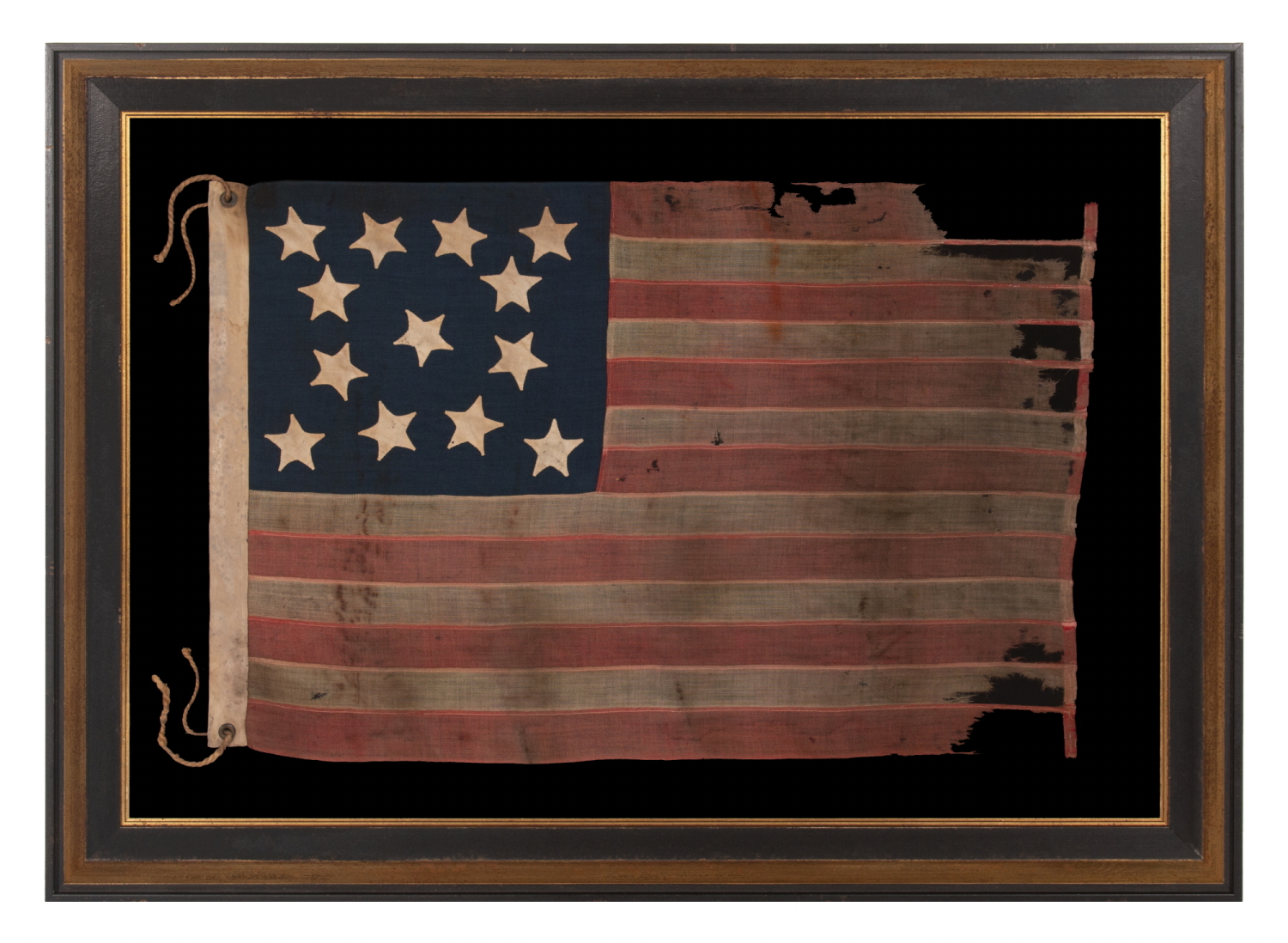
| |
13 STAR ANTIQUE AMERICAN FLAG WITH A MEDALLION CONFIGURATION OF HAND-SEWN STARS AND EXCEPTIONALLY ENDEARING GRAPHIC QUALITIES FROM HAVING BEEN EXTENSIVELY FLOWN; A SMALL SCALE EXAMPLE, MADE IN THE ERA OF THE 1876 CENTENNIAL OF AMERICAN INDEPENDENCE |
|
| Available: |
Sold |
| Frame Size (H x L): |
35.75" x 48.75" |
| Flag Size (H x L): |
25.25" x 36.5" |
|
| Description....: |
|
13 star American national flag, made in the era of the 1876 centennial of American independence, with hand-sewn stars and exceptionally endearing wear from long-term use, and in an extremely small scale amongst its 19th century counterparts. The stars are arranged in a medallion pattern that features a wreath of 8 stars, surrounding a single, center star, with a flanking star in each corner of the navy blue canton. This attractive design emerged during the Civil War and became very popular afterwards, especially on small, hand-held, printed flags, made for the celebration of our nation’s 100th anniversary.
The stars are made of cotton, hand-sewn, and double-appliquéd (applied to both sides). The canton and stripes of the flag are made of wool bunting that has been pieced and joined with treadle stitching. There is a heavy twill binding along the hoist with two brass grommets. There is a particularly nice pair of hemp rope ties, rather thick and attractive in both style and color, placed one each at the top and bottom of the hoist.
The small scale of the flag itself is very desirable. Prior to the last decade of the 19th century, most flags made for extended outdoor use were very large. Those with pieced-and-sewn construction were generally eight feet long and larger. This is because flags needed to be seen from a distance to be effective in their purpose as signals. Today their use is more often decorative and the general display of patriotism. Smaller flags exist in the early periods, but they are very much the exception as opposed to the rule. A six-foot example is small among flags of those that pre-date 1890, and they smaller they are, the more unusual they are. Beginning around 1890, flag-makers started producing 3- and 4-foot examples for the first time in quantity. These almost universally displayed 13 stars, emulating Navy use of 13 star flags on small craft.
In spite of the above characteristics, all of which are especially desired, the most notable trait resides in the flag’s endearing wear from having been extensively flown. The combination of soiling, fading, and losses results in exceptional, visual presentation.
Why 13 Stars?
13 star flags have been continuously produced throughout our nation’s history for purposes both patriotic and utilitarian. This was the original number of stars on the American flag, representing the original 13 colonies, so it was appropriate for any flag made in conjunction with celebrations of American independence. In addition to use at the 1876 centennial, 13 star flags were hoisted at patriotic events, including Lafayette’s visit in 1824-25, the sesquicentennial in 1926, and celebrations of July 4th. They were displayed during the Civil War, to reference past struggles for American liberty and victory over oppression, and were used by 19th century politicians while campaigning for the same reason.
13 star flags were flown by American ships both private and federal. The U.S. Navy used 13 stars on the ensigns made for small boats, because they wished the stars to be easily discerned at a distance. As the number of stars grew with the addition of new states, it became more and more difficult to fit stars on a small flag so that they may be viewed from afar as individual objects. Because any star count that has previously been official remains so today according to the Congressional flag acts, all 13 star flags in an otherwise appropriate design remain official flags of the United States.
Mounting: The flag was mounted and framed within our own conservation department, which is led by expert staff. We take great care in the mounting and preservation of flags and have framed thousands of examples.
The black-painted, hand-gilded and distressed molding is Italian. The background is 100% cotton twill, black in color. The glazing is U.V. protective acrylic (Plexiglas). Feel free to contact us for more details.
Condition: There is significant fabric loss from wind shear along the fly end, especially in the upper and lower corners, as well as along the top edge of the first stripe. There is a moderate hole in the upper, hoist end corner of the canton and there are minor losses elsewhere throughout. There is moderate to significant foxing and staining throughout, accompanied by significant fading throughout the red stripes. There is minor to modest bleeding of the red dye. Many of my clients prefer early flags to show their age and history of use. |
|
|
|
| Collector Level: |
Flags for the truest Patriots. My best offerings |
|
| Flag Type: |
Sewn flag |
|
| Star Count: |
13 |
|
| Earliest Date of Origin: |
1876 |
|
| Latest Date of Origin: |
1876 |
|
| State/Affiliation: |
13 Original Colonies |
|
| War Association: |
|
|
| Price: |
SOLD |
|
| |
Views: 1049 |
|
|
|

